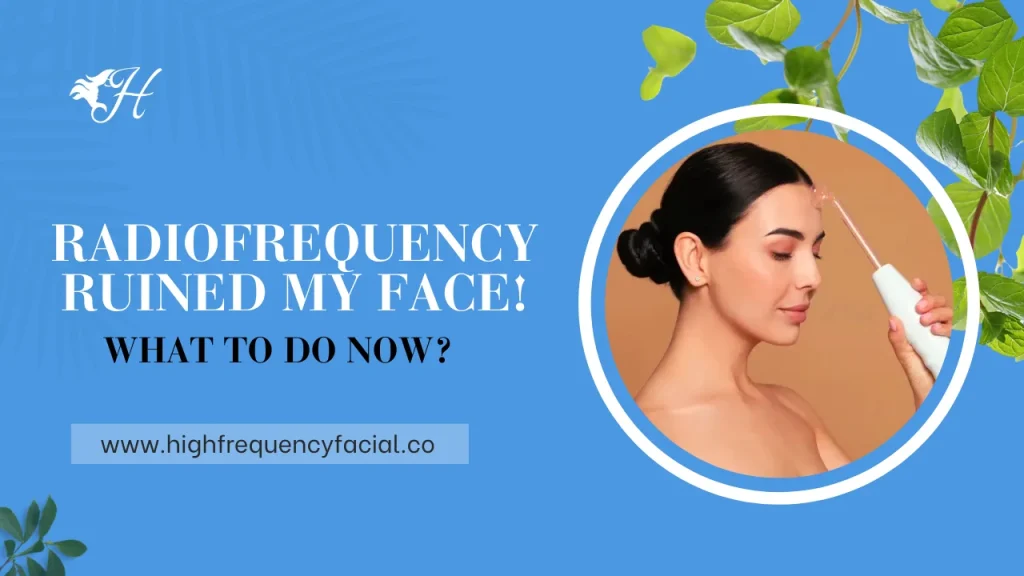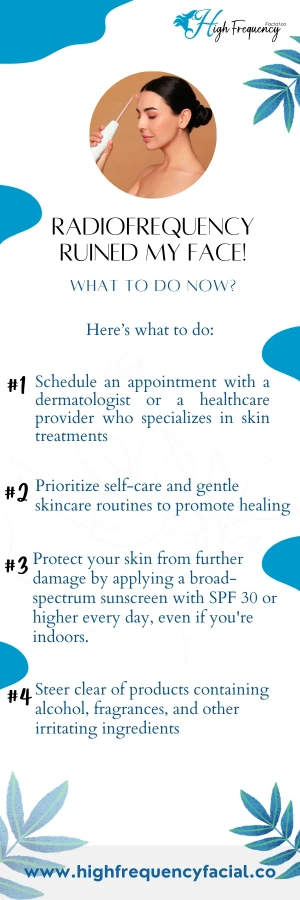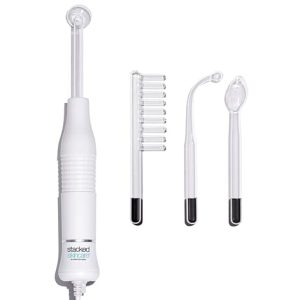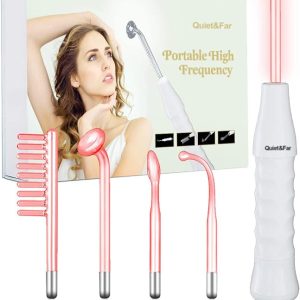Discovering that radiofrequency treatments have caused unexpected issues on your face can be really tough. You went in hoping for tighter, rejuvenated skin, but now you’re dealing with irritation, redness, or even more serious stuff like burns or scarring
If radiofrequency treatments have caused issues with your face, the next steps involve seeking professional guidance, focusing on gentle skincare, and considering potential treatment options to address the damage.


Radiofrequency Ruined My Face, What To Do Now?
Here are some essential steps and tips to consider if radiofrequency has ruined your face:
The first and most important step is to schedule an appointment with a dermatologist or a healthcare provider who specializes in skin treatments. They can assess the damage’s extent and recommend appropriate treatment steps.
Once you’ve consulted with a professional, follow their recommendations carefully. They may suggest topical treatments, oral medications, or other interventions depending on the severity of the issue.
If you believe the radiofrequency treatment was administered improperly or negligently, you may want to explore your legal options. Consult with a lawyer who specializes in medical malpractice to discuss your case.
In the meantime, prioritize self-care and gentle skincare routines to promote healing. Avoid harsh products and treatments that could further irritate your skin. Here are some ways you can treat your skin to get better:
- Moisturizers: Look for products with ingredients like hyaluronic acid, ceramides, and glycerin, which can help repair the skin barrier.
- Topical Steroids: If your skin is inflamed or irritated, your doctor will prescribe a topical corticosteroid to help reduce inflammation and redness.
- Antibiotics: In cases where there is a risk of infection, your doctor will prescribe antibiotics to prevent or treat any bacterial infections.
- Sunscreen: Protect your skin from further damage by applying a broad-spectrum sunscreen with SPF 30 or higher every day, even if you’re indoors. Choose a sunscreen that’s labeled “non-comedogenic” to avoid clogging pores.
- Avoid Harsh Products: Steer clear of products containing alcohol, fragrances, and other irritating ingredients that could further aggravate your skin.
- Hydrocortisone Cream: Over-the-counter hydrocortisone cream can help reduce inflammation and itching, but use it sparingly and as directed by your doctor, as prolonged use can thin the skin.
- Cool Compresses: Applying cool compresses to the affected area can help soothe inflammation and relieve discomfort.
- Drink Plenty of Water: Staying hydrated is essential for overall skin health. Drink plenty of water throughout the day to help your skin heal from the inside out.
Remember to always consult with a dermatologist or healthcare professional before starting any new skincare regimen or using prescription medications. They can provide personalized recommendations based on your specific needs and concerns.
Here’s How RF Treatment Can Ruin Your Face:
Some individuals experience adverse effects such as burns, blistering, scarring, or changes in skin pigmentation. These complications arise from factors like incorrect radiofrequency device settings, inadequate cooling during treatment, or using RF on unsuitable skin types.
Instances, where individuals claim “radiofrequency ruined my face” often involve over-treatment, excessive heating, or unsuitability for treatment.
A personal account shared her personal experience of RF via email. The individual suffered severe burns and scarring on her face following an RF session, despite following post-treatment care instructions, because the practitioner was inexperienced. This experience shows the necessity of researching providers, verifying qualifications, and seeking consultations before undergoing any cosmetic procedure.
“One of the biggest concerns with RF treatments is the potential for over-tightening. When the skin is pulled too tight, it can give a person a ‘windblown’ look that is far from natural.”
Dr. Joshua Zeichner, Director of Cosmetic and Clinical Research in Dermatology
While RF treatments offer skin tightening benefits, acknowledging potential risks and exercising caution is crucial to minimize adverse outcomes.
Dangers of RF Treatment:
The dangers of radiofrequency treatment include:
- burns
- blistering
- scarring
- changes in skin pigmentation.
Several factors contribute to these dangers:
Incorrect device settings, such as using too high energy levels or improper cooling during treatment, increase the risk of burns or blistering. Additionally, RF treatments may not be suitable for all skin types, and using them on unsuitable skin leads to adverse reactions.
How To Prevent These Dangers?
To prevent these dangers:
- it’s essential to choose a qualified and experienced provider who understands how to properly perform RF treatments.
- Ensure that the provider selects appropriate settings for your skin type and condition
- Ensure that the provider closely monitors the treatment process to avoid overexposure or excessive heating.
- Individuals should undergo a thorough consultation to assess their candidacy for the procedure and discuss any potential risks or concerns.
- Follow post-treatment care instructions diligently to help minimize the risk of complications. This includes avoiding sun exposure, using recommended skincare products, and attending follow-up appointments.


How Do You Know if Radiofrequency Was Done Wrong?
Determining whether radiofrequency (RF) treatment was performed incorrectly involves assessing several factors:
- Visible Signs of Damage: Obvious indicators such as burns, blistering, excessive redness, or scarring on the treated area.
- Uneven Results: If the treated area shows irregularities in texture, tone, or firmness.
- Persistent Side Effects: Prolonged discomfort, pain, or swelling beyond the expected recovery period.
- Lack of Improvement: If there is minimal to no improvement in the targeted skin concerns, such as wrinkles, sagging, or texture irregularities, after completing a series of RF treatments.
- Inadequate Consultation and Follow-up: If the provider fails to conduct a thorough consultation to assess skin suitability, discuss expectations, and provide post-treatment care instructions.
- Unprofessional Conduct: Instances of unprofessional behavior, such as inadequate communication, rushing through the procedure, or neglecting safety protocols, indicates substandard treatment practices.
What You NEED to Know About Treatments Like Radiofrequency
When considering treatments like radiofrequency (RF), here’s what you need to know:
- Safety: RF treatments are generally safe but sometimes carry risks such as burns or scarring if not administered properly.
- Suitability: Not everyone is a suitable candidate for RF treatments. Factors like skin type and medical history should be considered.
- Results and Timeline: Multiple sessions spaced over weeks are often needed for optimal results. Changes are typically noticeable within months after completing treatment.
- Maintenance: Periodic maintenance sessions are required to sustain results. Follow post-treatment care instructions diligently.
- Choosing a Provider: Select a qualified and experienced provider to ensure safe and effective treatment.
- Realistic Expectations: Understand that results vary, and complete transformation may not be achievable. Discuss expectations with your provider.
Conclusion:
In conclusion, radiofrequency (RF) treatments offer a non-invasive solution for skin tightening and rejuvenation. While generally safe and effective when administered by qualified professionals, there are inherent risks involved. Adverse effects such as burns, blistering, and scarring can occur if treatments are not conducted properly.
It’s crucial to choose a qualified provider, undergo a thorough consultation, and follow post-treatment care instructions diligently to minimize risks and optimize results. Realistic expectations and understanding the timeline for results are also essential.





